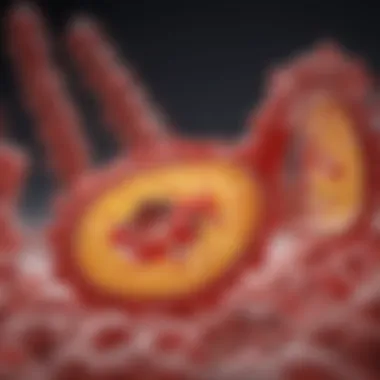LDL Cholesterol Management: Insights and Strategies


Intro
Managing LDL cholesterol is crucial for heart health. High levels of LDL cholesterol can lead to atherosclerosis, which increases the risk of cardiovascular diseases. Understanding the role that LDL cholesterol plays in the body is essential for any individual aiming to take control of their health.
In this article, we will explore key insights and strategies that can assist in managing LDL cholesterol effectively. This will illuminate not only the importance of monitoring LDL levels but also the implications of what those levels mean for overall health. We will delve into dietary modifications, pharmaceutical options, and lifestyle adjustments that can contribute to healthier cholesterol levels.
By synthesizing findings from current research, we can present a coherent guide for students, educators, and professionals. The objective is to empower readers with knowledge that can impact their health decisions regarding LDL cholesterol management.
Research Highlights
Overview of Key Findings
Understanding LDL cholesterol begins with its biological role. LDL, or low-density lipoprotein, carries cholesterol through the bloodstream. While the body needs some cholesterol for cell formation and hormone production, excess LDL cholesterol can lead to plaque buildup in arteries.
Recent findings indicate several strategies to manage LDL cholesterol effectively:
- Dietary Changes: Increasing intake of soluble fiber and healthy fats can help lower LDL levels.
- Physical Activity: Regular exercise has shown to improve cholesterol profiles.
- Medications: Statins and other lipid-modifying agents are commonly used to manage high cholesterol levels.
Significance of the Research
The significance of understanding LDL cholesterol management lies in its direct impact on cardiovascular health. Research has demonstrated that lowering LDL cholesterol can reduce the likelihood of heart disease and related events.
Public health initiatives targeting cholesterol management have gained attention as a preventive measure against cardiovascular diseases. This highlights the need for both individual and community education on this critical topic.
"Reducing LDL cholesterol is one of the key strategies in preventing cardiovascular diseases."
Original Research Articles
While our discussion primarily synthesizes various studies, referencing original research serves to validate our approach. Each study contributes valuable insights into LDL cholesterol management strategies:
Summary of the Article
Research has indicated that lifestyle interventions, particularly diet and exercise, significantly impact LDL cholesterol levels. The Clinical Journal of the American Society of Nephrology has published multiple articles detailing these interventions and their efficacy.
Author Contributions
Each contributing author has focused on different aspects of LDL management, from dietary recommendations to the effects of pharmaceuticals. Their collective work underscores the importance of a multifaceted approach to managing cholesterol effectively. This collaborative effort enriches our understanding of how different strategies can lead to better health outcomes.
By learning about these strategies and principles, individuals can make informed decisions about their health, effectively managing their LDL cholesterol and thus improving their quality of life.
Understanding Cholesterol
Understanding LDL cholesterol is essential in addressing cardiovascular health effectively. Low-density lipoprotein, commonly known as LDL, plays a misleading role in heart health. Often termed "bad cholesterol," high levels of LDL can lead to atherosclerosis, which is a buildup of fats and cholesterol in artery walls. This buildup can restrict blood flow and increase the risk of heart attacks and strokes.
Health professionals and researchers emphasize the necessity of monitoring LDL levels as part of routine health assessments. Understanding the implications of elevated LDL can prompt individuals to adopt necessary lifestyle changes or seek medical assistance. The goal is to maintain optimal LDL levels while enhancing overall vascular health through informed decisions.
Definition and Role
LDL cholesterol is a type of lipoprotein that transports cholesterol throughout the body. Its primary function is to deliver cholesterol, a crucial component for cellular membranes, hormone synthesis, and vitamin D production, to tissues that require it. However, when there is an excess of LDL cholesterol in the bloodstream, it can lead to the formation of plaques in the arteries. This process significantly increases the risk of cardiovascular issues. Thus, while LDL serves a necessary biological purpose, its management is vital for preventing heart disease.
Physiological Importance
Cholesterol is integral to various physiological processes. In this context, LDL's role should not be overlooked. It facilitates the transport of lipids within the circulatory system, which is necessary for numerous cellular functions. However, excessive amounts of LDL can have adverse effects. When LDL particles become oxidized, they can trigger inflammatory responses in arterial walls, leading to plaque formation and narrowing of the arteries. This physiological understanding underscores the critical balance required in cholesterol levels, particularly regarding LDL and cardiovascular health.
vs. HDL: A Comparative Overview
Comparison between LDL and high-density lipoprotein (HDL) illustrates the complexities of cholesterol management. Unlike LDL, HDL is known as "good cholesterol" because it helps remove cholesterol from the bloodstream, transporting it back to the liver for recycling or elimination. The balance between these two types of cholesterol is essential. High levels of HDL may help mitigate some risks associated with high LDL levels, promoting cardiovascular health.
- LDL Cholesterol
- HDL Cholesterol
- Transports cholesterol to tissues
- High levels contribute to plaque buildup
- Clears cholesterol from the bloodstream
- Protective against heart disease


Maintaining a healthy balance between LDL and HDL is crucial for overall health. This understanding can empower individuals to make informed choices regarding diet, exercise, and medical treatments for optimizing their cholesterol profiles.
The Impact of High Cholesterol
The importance of understanding the impact of high LDL cholesterol cannot be overstated. Elevated levels can lead to severe health implications, particularly regarding cardiovascular health. This section explores the profound effects that high LDL cholesterol levels have on the body, focusing on key considerations that can guide both individuals and health professionals in managing risks associated with this condition.
Cardiovascular Disease Risk
High levels of LDL cholesterol are a significant risk factor for cardiovascular diseases. LDL, often referred to as "bad" cholesterol, contributes to the buildup of fatty deposits in arteries. These deposits can restrict blood flow, leading to a condition known as atherosclerosis. As plaque accumulates, the risk of heart attacks and strokes increases, making the monitoring and management of LDL cholesterol crucial.
Studies suggest that maintaining LDL cholesterol levels below 100 mg/dL can significantly reduce the risk of developing heart disease. Many patients, especially those with a history of cardiovascular issues or familial hypercholesterolemia, must keep even lower levels. Monitoring LDL cholesterol is essential in evaluating an individual’s cardiovascular risk and adjusting treatment accordingly.
"Managing LDL cholesterol is not only about numbers; it is about understanding the broader implications for heart health and overall well-being."
Other Health Consequences
Beyond cardiovascular diseases, high LDL cholesterol can lead to various other health issues. Research has shown that elevated LDL levels can affect the liver and the pancreas, thereby increasing the risk of diabetes and non-alcoholic fatty liver disease. Increased LDL levels may also be linked to other conditions, such as peripheral artery disease, which can cause pain and mobility issues.
The inflammatory response caused by high LDL cholesterol is also important to recognize. When the body detects high levels of LDL, it may trigger inflammation, leading to chronic health issues. Managing cholesterol levels effectively can thus help reduce not just the risk of heart disease but also improve overall health and quality of life.
Assessing Cholesterol Levels
Assessing LDL cholesterol levels is a cornerstone in the management of cardiovascular health. Understanding one’s cholesterol profile can provide critical insights into potential health risks and necessary interventions. Regular assessments are vital for detecting abnormalities early and implementing appropriate strategies to minimize risks associated with high LDL cholesterol.
Blood Tests for Cholesterol Measurement
The primary method for assessing LDL cholesterol is through blood tests. These tests measure various types of cholesterol and can provide a comprehensive picture of one's lipid profile. Typically, fasting blood tests are recommended to ensure accuracy. The most common tests include the lipid panel, which measures total cholesterol, LDL cholesterol, high-density lipoprotein (HDL) cholesterol, and triglycerides. This information is essential because it helps healthcare providers identify which lipid components are elevated and tailor management strategies accordingly.
Understanding Lipid Profiles
A lipid profile offers an overview of the different lipid components in the bloodstream, with specific focus on LDL and HDL levels. An optimal total cholesterol level is generally below 200 mg/dL, while LDL cholesterol should ideally be below 100 mg/dL. In contrast, high levels of HDL cholesterol, usually above 60 mg/dL, are considered protective against heart disease. An understanding of these values not only aids in diagnosis but also informs lifestyle and treatment options.
Regular monitoring is essential to understand long-term trends and make necessary adjustments to lifestyle or medical treatments.
Dietary Strategies for Management
Dietary strategies play a critical role in managing LDL cholesterol levels. The connection between diet and cholesterol is profound. Certain foods can promote heart health while others can enhance LDL levels, leading to potential cardiovascular issues. By adjusting dietary habits, individuals can not only lower their LDL cholesterol but also embrace a healthier lifestyle overall. This section aims to provide clear insights into principles of a heart-healthy diet, specific food choices, and the importance of dietary fiber.
Heart-Healthy Diet Principles
A heart-healthy diet is designed with an emphasis on protecting cardiovascular health. This involves focusing on foods that have been shown to have beneficial effects on cholesterol levels. Key principles include:
- Emphasis on Whole Foods: Eating a variety of fruits, vegetables, whole grains, and lean proteins helps provide essential nutrients while minimizing intake of unhealthy fats.
- Increased Unsaturated Fats: Replacing saturated fats with unsaturated fats can help reduce LDL levels. Sources include nuts, seeds, avocados, and olive oil.
- Limiting Processed Foods: Highly processed foods often contain trans fats and added sugars, which can negatively affect cholesterol levels and overall health.
- Portion Control: Maintaining appropriate portion sizes can help manage weight, which directly impacts LDL cholesterol.
Foods to Include and Avoid
The food choices made daily impact cholesterol levels significantly. Here are some foods to include in a diet aimed at managing LDL:
Foods to Include:
- Oats and Barley: These whole grains are rich in beta-glucans, which can help reduce cholesterol absorption.
- Fatty Fish: Salmon, mackerel, and sardines are high in omega-3 fatty acids that can improve heart health.
- Legumes: Beans, lentils, and chickpeas provide protein and fiber, both of which are beneficial for lowering LDL.
- Nuts: Almonds and walnuts are effective at reducing levels of LDL cholesterol when consumed in moderation.
Foods to Avoid:
- Red Meat: Contains high amounts of saturated fat, which elevates LDL cholesterol.
- Full-Fat Dairy Products: Cheese, butter, and cream can also be high in saturated fat.
- Trans Fats: Often found in margarine and baked goods, trans fats are particularly harmful to cholesterol levels.
The Role of Dietary Fiber
Dietary fiber is a vital component in the fight against high LDL cholesterol. It is recognized for its ability to bind with cholesterol in the digestive system, aiding in its excretion. Some important points about dietary fiber include:
- Types of Fiber: Soluble fiber, found in oats, apples, and beans, is particularly effective in lowering cholesterol.
- Daily Intake: Aim for at least 25 to 30 grams of total fiber per day. Including a variety of fiber sources will help reach this goal.
- Health Benefits: In addition to managing LDL levels, fiber supports digestive health and aids in weight management, further providing cardiovascular benefits.
Important Note: Incorporating dietary changes gradually is ideal. Sudden changes can lead to discomfort. It's crucial to allow your body to adjust to increased fiber intake, particularly.


By understanding the principles of a heart-healthy diet, selecting the right foods, and acknowledging the importance of fiber, individuals can take informed steps towards effective LDL cholesterol management. Establishing these dietary strategies offers a proactive approach to maintaining heart health.
Pharmaceutical Interventions
Pharmaceutical interventions play a crucial role in the effective management of LDL cholesterol levels. Medications can help lower the risk of cardiovascular diseases and other health issues linked to high LDL cholesterol. With advancements in medicine, various options are available to individuals who require assistance beyond lifestyle changes and dietary modifications. These interventions can significantly improve health outcomes, but they must be considered carefully.
Statins: Mechanism and Efficacy
Statins are a class of drugs commonly prescribed to manage high levels of LDL cholesterol. Their primary mechanism of action is to inhibit the enzyme HMG-CoA reductase, which is crucial in cholesterol synthesis in the liver. By doing so, statins effectively lower the production of cholesterol, leading to a decrease in overall blood cholesterol levels, particularly LDL cholesterol.
The efficacy of statins is well-documented. Many clinical trials have shown that statins can reduce the risk of heart attacks and strokes. For instance, the use of atorvastatin and simvastatin has demonstrated a significant ability to lower LDL levels. In most cases, patients may expect a reduction of approximately 30% to 50% in LDL cholesterol over weeks to months of therapy.
Despite their benefits, patients should also be aware of potential side effects, which can include muscle pain, liver enzyme abnormalities, and digestive issues. Close medical supervision is advised during statin therapy to manage these effects.
Alternative Medications
While statins are the first line of defense against high LDL cholesterol, alternative medications are also available for those who may not tolerate statins or require additional support.
- Ezetimibe: This medication works by inhibiting the absorption of cholesterol in the intestines. It can be used alone or in conjunction with statins for enhanced effect.
- PCSK9 Inhibitors: Such as alirocumab and evolocumab are newer drugs that significantly lower LDL cholesterol levels. These injectable medications target the protein PCSK9, which can lead to increased receptors that clear LDL cholesterol from the blood.
- Bile Acid Sequestrants: Like cholestyramine, they work by binding bile acids in the intestines, prompting the liver to use more cholesterol to produce new bile acids, thereby lowering LDL levels.
These alternative options can provide needed flexibility in treatment regimens, catering to the specific needs of individual patients, particularly those with contraindications to statins.
Assessing Risks and Benefits
When considering pharmaceutical interventions, it is essential to assess the inherent risks and benefits thoroughly. Every medication carries potential side effects, making it critical to weigh these against the expected therapeutic outcomes.
- Benefits:
- Risks:
- Significant reduction in LDL cholesterol levels
- Decreased risk of major cardiovascular events
- Improved quality of life for individuals with high cholesterol levels
- Possible side effects specific to each medication
- Long-term use may result in unforeseen health consequences
- Interactions with other medications or bio-molecules in the body
"The choice of starting medication should be personalized, taking into account the individual’s overall health status, risk factors, and personal preferences."
A collaborative approach between healthcare providers and patients can help ensure that treatment decisions support optimal health outcomes.
Lifestyle Modifications
Lifestyle modifications play a crucial role in managing LDL cholesterol levels effectively. These changes can significantly impact both heart health and overall well-being. Incorporating healthier habits not only helps in reducing LDL cholesterol but also contributes to better physical fitness, enhanced mental clarity, and improved quality of life. This section will provide insight into essential lifestyle modifications, focusing on physical activity, weight management, and stress management.
Physical Activity Recommendations
Engaging in regular physical activity is fundamental to maintaining healthy cholesterol levels. Exercise helps increase high-density lipoprotein (HDL) cholesterol, often referred to as 'good' cholesterol, while lowering overall LDL levels. It is recommended that adults aim for at least 150 minutes of moderate-intensity aerobic exercise per week. Activities can include brisk walking, cycling, or swimming. Additionally, incorporating strength training at least two times a week can further enhance metabolism and improve cardiovascular health.
A few key benefits of physical activity include:
- Improved circulation: Regular exercise enhances blood flow, which aids in lipid metabolism.
- Weight control: Physical activity helps in maintaining a healthy weight, which is critical in managing LDL cholesterol levels.
- Lower stress: Exercise often acts as a natural stress reliever, thereby benefiting overall heart health.
Weight Management Strategies
Managing weight is another important factor in controlling LDL cholesterol. Excess body weight can lead to an increase in LDL cholesterol and a decrease in HDL cholesterol. Being overweight is also associated with other risk factors that contribute to cardiovascular disease, such as hypertension and diabetes. Effective weight management strategies include following a balanced diet rich in whole foods and engaging in physical activity.
To achieve and maintain a healthy weight:
- Monitor your diet: Tracking food intake can help individuals understand their eating patterns and make necessary adjustments.
- Portion control: Being mindful of portion sizes is essential in preventing overeating.
- Set realistic goals: Gradual weight loss (1 to 2 pounds per week) is more sustainable and healthier than rapid weight loss.
Stress Management and Cholesterol
Stress can have a significant impact on cardiovascular health, including cholesterol levels. Chronic stress may lead to unhealthy behaviors such as poor diet choices and lack of exercise, which can elevate LDL cholesterol. Understanding and managing stress is essential for overall health and LDL management.
Several effective stress management strategies can be adopted, including:
- Mindfulness and meditation: These practices can help reduce anxiety and promote relaxation, positively affecting heart health.
- Regular exercise: Physical activity boosts endorphins, which help improve mood and reduce stress.
- Adequate sleep: Good sleep hygiene supports overall health, including stress levels, which in turn can impact cholesterol.


"Managing stress is as important as diet and exercise in controlling LDL cholesterol levels."
Monitoring and Reevaluation
Monitoring LDL cholesterol levels is crucial in managing cardiovascular health. It enables healthcare providers and patients to track the effectiveness of existing strategies and make necessary adjustments. Regular evaluations help in understanding if one is at risk or if current management is sufficient. Emphasizing the need for a proactive approach to health, this section delves into specific elements such as testing schedules and adaptive strategies.
Regular Check-ups and Testing Schedules
Regular check-ups form the backbone of effective monitoring. It is recommended that adults have their cholesterol levels checked every four to six years. However, individuals with risk factors like diabetes, hypertension, or a family history of heart disease might require more frequent assessments. These tests usually measure total cholesterol, LDL, HDL, and triglycerides.
Check-ups should not merely consist of testing; they also involve discussions about dietary habits, physical activity, and any recent health changes. A patient's history aids in forming a more comprehensive view of their health. Such discussions are essential in tailoring recommendations based on individual needs.
"Monitoring is the first step toward making informed lifestyle and treatment choices. It is enlightening to evaluate progress regularly."
Adapting Management Strategies
Adapting management strategies based on monitoring is paramount. When test results indicate high LDL levels despite current interventions, it may signal a need for reevaluation. Factors to consider include changing dietary patterns, increasing physical activities, or even modifying medications.
Health care providers often utilize a dynamic approach where they adjust medications or recommend dietary changes tailored to the individual's response.
Here are a few considerations for adapting these strategies:
- Lifestyle Changes: Gradual changes, such as incorporating a Mediterranean diet, may be beneficial.
- Medication Adjustments: Depending on individual responses, increasing dosage or switching medications like statins may be necessary.
- Integrating New Findings: With ongoing research, staying informed on emerging treatments can also aid in adjusting your approach effectively.
Ultimately, the goal is to ensure that LDL cholesterol levels remain within the target range and to maintain overall heart health.
Individualized Treatment Approaches
Individualized treatment approaches in LDL cholesterol management are essential for achieving optimal health outcomes. Each person has unique health conditions, lifestyles, and risk factors that can influence their cholesterol levels and overall cardiovascular risk. By tailoring treatment strategies to fit individual needs, healthcare providers can enhance the effectiveness of interventions and promote better adherence to treatment plans.
Patient-Specific Factors in Management
When managing LDL cholesterol, recognizing patient-specific factors is crucial. These factors can include:
- Age and Gender: Different age groups and genders may respond differently to specific treatments. For instance, post-menopausal women often experience changes in cholesterol levels due to hormonal shifts.
- Genetics: Genetic predisposition can significantly affect cholesterol metabolism. Patients with familial hypercholesterolemia, for example, may require more aggressive treatment compared to those without such a history.
- Comorbidities: The presence of other health conditions, such as diabetes, hypertension, or metabolic syndrome, must be considered. These conditions can interact with cholesterol management strategies.
- Lifestyle: Individual habits, including diet, physical activity, and smoking status, need assessment. Personalized lifestyle modifications can sometimes suffice to lower LDL levels.
It is important for healthcare providers to gather detailed patient histories and conduct thorough assessments to determine the most suitable treatment options.
Collaborative Care Models
Collaborative care models emphasize teamwork in managing LDL cholesterol effectively. These models involve various healthcare professionals working together to devise and implement individualized treatment plans. Benefits of this approach include:
- Holistic Treatment: With input from doctors, dietitians, and fitness experts, patients receive comprehensive care that addresses multiple aspects of health.
- Enhanced Communication: Regular interactions among healthcare providers ensure that all team members are informed about the patient’s progress and any adjustments needed.
- Shared Decision-Making: Engaging patients in their care encourages better understanding and adherence to treatment plans. Patients are more likely to follow through when they feel involved in the process.
"An effective collaborative care model fosters a supportive environment that maximizes patient engagement and health outcomes."
The integration of these strategies into LDL cholesterol management can result in more efficient monitoring and adjustments in therapy, ensuring that each patient is on the most effective path to heart health.
Emerging Research and Future Directions
Emerging research in LDL cholesterol management is crucial, as it aims to advance our understanding and treatment of hyperlipidemia. Studies indicate that common therapies may not be sufficient for all patients, pushing researchers to explore innovative interventions. This section discusses innovative therapies currently in development and the implications of longitudinal studies.
Innovative Therapies in Development
Research is focused on novel therapies that go beyond traditional statins. These include PCSK9 inhibitors, which block proteins that degrade LDL receptors. By enhancing the liver's ability to clear LDL cholesterol from the blood, these treatments can significantly lower cholesterol levels in certain populations.
- New drugs in the pipeline also target metabolic pathways directly, such as antisense oligonucleotides. These medications work by specifically reducing the production of apolipoprotein B, a main component of LDL.
- Gene therapy is another frontier, offering the potential for a single treatment approach that could provide lasting LDL reduction.
- Additionally, research into natural compounds like berberine is ongoing, evaluating effects on LDL and overall lipid profile.
"The continuous evolution of LDL management underscores the need for adaptation and understanding of upcoming therapies to improve cardiovascular health."
Longitudinal Studies and Their Implications
Longitudinal studies have become essential for assessing the long-term effects of LDL cholesterol management strategies. These studies track patients over extended periods, providing insights into the effectiveness and safety of various interventions. Results from such research inform clinical guidelines and help tailor treatments to individual patients.
- Findings from longitudinal studies include:
- The identification of specific population groups less responsive to standard treatments.
- Insights into the relationship between LDL cholesterol levels and cardiovascular events over time.
- Assessments of adherence to treatment and the impact on cholesterol levels.
The implications of these studies are profound. They inform healthcare providers about patient outcomes, regulatory decisions, and the development of personalized treatment plans.
In summary, ongoing innovations in LDL cholesterol management and the results from longitudinal studies not only enhance our current understanding but also pave the way for future treatment strategies. This guarantees a more effective management system for patients afflicted with dyslipidemia.







